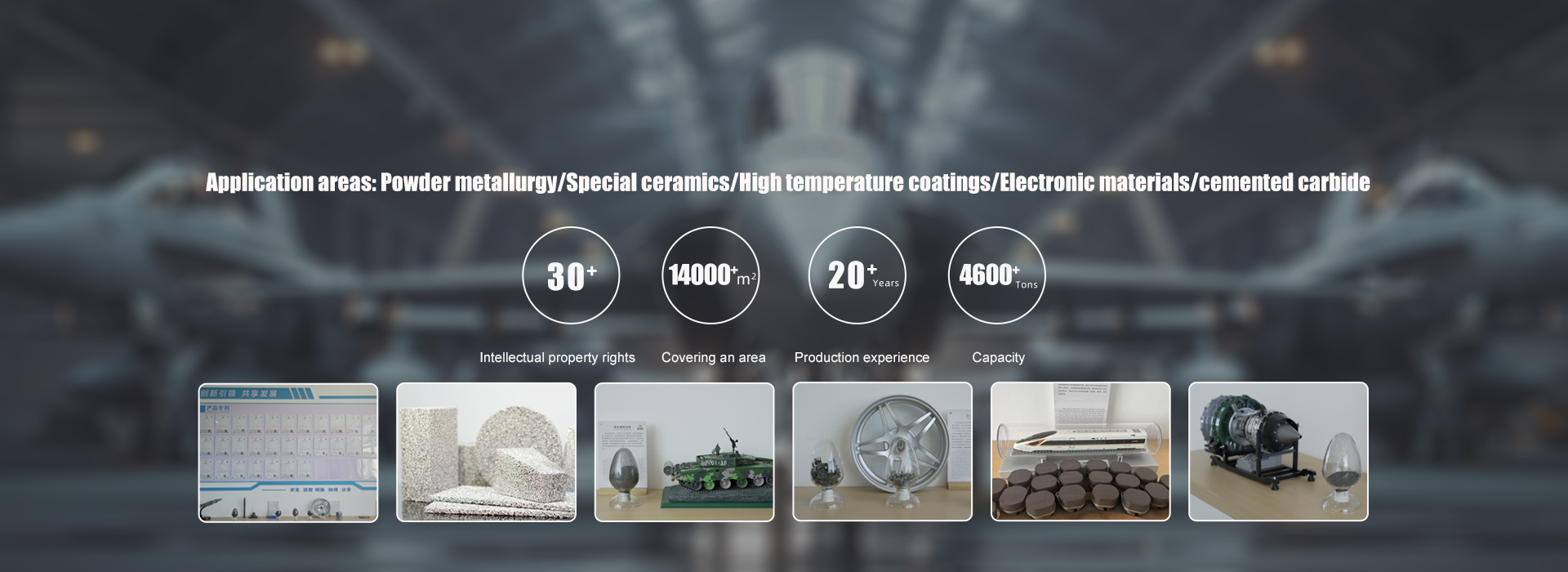Vanadium
The fourth period VB group elements of the periodic table are rare high melting point metals. Element symbol V, atomic number 23, relative atomic mass 50.9415, solid at room temperature, gray in powder form, and steel gray in dense form.
In 1801, Mexican mineralogist A.M. DelRio discovered a new element while studying sphalerite, which had chemical properties similar to chromium and uranium. Its salts turned red when heated in acid, hence the name "erythronium", meaning "red element". However, it was later mistakenly believed to be alkaline lead chromate. In 1831, Swedish chemist N.G. Sefstrom discovered a new element while smelting pig iron, and its compounds were beautiful and colorful, so he named it Vanadium after the Swedish goddess "Venus". Vanadium was used as a coloring agent in 1860. In 1867, British chemist H.E. Roscoe reduced VCl with hydrogen, obtaining for the first time relatively pure silver gray metallic vanadium powder. In 1869, France researched the use of vanadium as an alloying agent for the production of armored steel plates. In 1896, vanadium was used as a special steel additive in Europe. Vanadium was used as a catalyst in 1870. Around 1905, vanadium containing alloy steel was used as a raw material for the automotive industry. In 1927, J.W. Madden and M.N. Rich in the United States used the electric furnace calcium thermal reduction method to produce industrial vanadium metal.
The vanadium industry in China started in the 1950s. In 1958, the vanadium extraction workshop of Jinzhou Ferroalloy Plant was restored and expanded, using vanadium bearing iron concentrate from Chengde Damao as the raw material for vanadium extraction. After 1960, other vanadium extraction plants in China were successively built and put into operation. In the 1970s, Panzhihua Iron and Steel Company was built and put into operation, marking a new historical period for China's vanadium industry. By the 1980s, China had become one of the world's major vanadium producing countries, capable of producing various vanadium products. The promotion and application of vanadium have also developed rapidly.
Vanadium has good plasticity and malleability, and can be made into sheets, drawn into wires, and processed into foils at room temperature. However, small amounts of impurities, especially interstitial elements such as carbon, hydrogen, oxygen, and nitrogen, can significantly affect the physical properties of vanadium. If vanadium contains 0.01% hydrogen, it will cause embrittlement and reduce plasticity; When the carbon content reaches 2.7%, its melting point rises to 2458K. Vanadium has a high melting point, high hardness, high electrical resistivity, weak paramagnetism, low coefficient of linear expansion, and elastic modulus and density similar to steel. It can be used as a structural material.
Vanadium is a transition element with an outer electron layer configuration of [Ar] 3d34s2, where all 5 electrons can participate in bonding. Therefore, vanadium is a variable valence element with 8 valence states ranging from -3 and -1 to+5, among which the+5 valence vanadium compound is the most stable. Compounds of pentavalent vanadium have oxidizing properties, while compounds of low valence vanadium have reducing properties. The lower the valence state of vanadium compounds, the stronger their reducing properties. Therefore, V3+and V2+are strong reducing agents. Vanadium easily forms complexes with many ligands.
Vanadium has 9 isotopes with mass numbers ranging from 46 to 54, and 51V is a stable natural isotope. The corrosion resistance of vanadium is second only to niobium and tantalum. At room temperature, vanadium does not react with air, water, and alkali, but at high temperatures, it can form compounds with most non-metallic elements such as carbon, silicon, nitrogen, oxygen, sulfur, chlorine, and bromine. Vanadium is resistant to seawater corrosion, as well as corrosion from hydrochloric acid, dilute sulfuric acid, and alkaline solutions. Vanadium does not react with other halogen acids at room temperature except for slow reaction with hydrofluoric acid. Vanadium reacts with oxygen-containing acids (hot concentrated sulfuric acid, hypochlorous acid, nitric acid, and aqua regia) to form vanadate salts.
Common vanadium compounds include oxides, halides, ammonium salts, sodium salts, and oxygen-containing acid salts. The properties of these compounds are often influenced by changes in the valence state of vanadium.
The main oxides of vanadium oxide are V205, V02, V203, and V0.
The chemical stability of vanadium halides decreases as the valence of vanadium atoms increases; The chemical stability of vanadium halides with the same valence state gradually decreases from fluoride to iodide.
Ammonium salts mainly include ammonium metavanadate (NH4VO3), ammonium vanadate [(NH4) 3VO4 or 2 (NH4) 20 • 3V205 • nH20], ammonium polyvanadate, etc., among which ammonium metavanadate is the most important. Ammonium metavanadate is a white or light yellow crystal that begins to decompose when heated to 473K, with a density of 2304kg/m3. Ammonium metavanadate decomposes into NH3 and V205 in oxygen rich air at 523K temperature; Decompose into (NH4) 2O • 3V205 and V204 • 5V205 in air at temperatures of 523-613K, and into NH3 and V205 at temperatures of 693-713K; V205 was oxidized in a pure oxygen atmosphere at temperatures ranging from 583 to 598K. Ammonium metavanadate is heated to 473K in hydrogen to generate (NH4) 2O • 3V205, (NH4) 2O • V204 • 5V205 at 593K, V2013 and V203 at 673K, and V204 at 1273K. Ammonium metavanadate forms (NH4) 2O • V204 • 5V205 at 623K in CO2, N2, and Ar atmospheres, and V6013 at 673-773K temperatures. When steam is introduced and the temperature reaches 498K, ammonium metavanadate forms (NH4) 2O • 3V205.
The compounds in the V205-Na20 binary phase diagram of sodium vanadium salts include NaV6015 Na8V24063、NaV03,Na4V207、Na3V04。 Common salts in the NaV03-V205 phase diagram include sodium metavanadate (NaV03), sodium pyrovanadate (Na4V2O7), sodium orthovanadate (Na3V04), and sodium polyvanadate.
Oxalates of vanadium have low solubility except for alkali metal and alkaline earth metal vanadate salts, which are easily soluble in water. The common oxygen-containing acid salts of vanadium include sodium salts, ammonium salts, calcium salts, iron salts, etc. From the aggregation state of vanadium, it can be classified into orthovanadate (V043-), pyrovanadate (V2074-), metavanadate (V03-, V40124-), and polyvanadate (V40124-, V60162-, V100182-, V120312-).
Vanadium alloys and additives commonly used include vanadium iron, vanadium aluminum, molybdenum vanadium aluminum alloy, silicon manganese vanadium iron alloy, vanadium carbide, vanadium nitride and other specialized alloy additives. The standards for vanadium iron alloys vary from country to country. There are usually six grades containing 40% to 80% vanadium. There are four types of vanadium aluminum alloys containing 55%, 65%, 75%, and 85% vanadium. Molybdenum vanadium aluminum alloys generally contain 23% to 25% vanadium, 24% to 26% molybdenum, and 48% to 53% aluminum. Silicon manganese vanadium iron generally contains vanadium>42%, silicon<7%, and manganese<4.5%. Vanadium carbide generally contains 82% to 86% vanadium and 10.5% to 14.5% carbon. Vanadium nitride contains 78% to 82% vanadium, 10% to 12% carbon, and over 6% nitrogen.
Vanadium and its compounds have a certain degree of toxicity, which generally increases with the valence state of vanadium. Skin is prone to allergic reactions when exposed to vanadium. Industrial exposure can easily cause respiratory diseases, including paroxysmal dry cough accompanied by hemoptysis and irritation of the eyes, nose, and throat. Hemoglobin and red blood cells temporarily increase and then decrease, leading to anemia, sometimes conjunctivitis, severe throat irritation, stubborn dry cough, diffuse lung rales and bronchial spasms, and sometimes skin itching. Soluble vanadium enters the bloodstream, and the lethal dose for a healthy person weighing 70kg is only 30mg V205 (i.e. one woman weighing 0.43mg). The threshold limit values for some vanadium compounds are: V205 dust 0.5mg/m3, smoke or ultrafine powder 0.1mg/m3. The effects of vanadium on animal neurophysiology, including central nervous system dysfunction and cardiovascular disease, cannot be ignored. Vanadium has no significant effect on the metabolism of animals, and the toxicity of certain vanadium salts in the mouth and eyes is not significant. It can also reduce cholesterol in young people and animals; Intravenous injection is highly toxic. Acute exposure and absorption of high concentrations of vanadium can cause vasoconstriction, leading to congestion and bleeding in certain parts of the body and damaging the liver, kidneys, heart, and brain. Vanadium has been used in medicine to treat anemia, chlorosis, tuberculosis and diabetes. The maximum allowable vanadium content in drinking water is below 0.1mg/L.
Vanadium has excellent alloy and catalytic properties, and is widely used in the steel and chemical industries. 90% of the world's vanadium is used in the steel industry, 5% in the chemical industry, and the rest in non-ferrous metal alloys and other fields. Vanadium is added to steel to form vanadium carbide and vanadium nitride particles, which disperse and strengthen the steel, inhibit the growth of austenite grains, and improve the performance of the steel. Adding 0.05% to 0.1% vanadium to steel can increase its strength by 10% to 20%, improve its casting and welding properties, and reduce the weight of mechanical components. High speed tool steel containing 1% to 5% vanadium not only has high wear resistance, but also good plasticity and toughness. Vanadium is mainly used in the chemical industry to manufacture various catalysts and ceramic pigments. The application of vanadium in non-ferrous metal alloys is mainly used to produce vanadium aluminum alloys. Vanadium aluminum alloy has high yield strength and impact strength, and is used as a material for aircraft and spacecraft. The usage of vanadium in this area is increasing year by year, and in the United States, it has risen to 7% to 10% of the total vanadium consumption. In addition, single crystal vanadium can be used as a material for the electronics industry.
Vanadium deposits can be classified into magma secreting deposits, vanadium containing hydrothermal deposits, weathered residual deposits, and sedimentary deposits based on their mineralization reasons. The crustal abundance of vanadium is 136 × 10-4%, and seawater contains 1 × 10-7% vanadium. Vanadium in vanadium ore is mainly associated with iron, titanium, uranium, molybdenum, copper, lead, zinc, aluminum, or with carbonaceous rocks, phosphate ores, etc. Recently, petroleum ores with high vanadium content have also been discovered.
Vanadium vanadium titanium magnetite is the main resource for vanadium production, which can comprehensively utilize vanadium, iron, and titanium. The world's major vanadium deposits include the vanadium titanium magnetite deposit in Bushveld, central Transvaal, South Africa, with reserves of approximately 2 billion tons; Urals and Kachkanar of the former Soviet Union; Otam ä ki and Mustawala, Finland; Iron Mountain in Wyoming, USA; Vanadium titanium magnetite deposits in Panzhihua, Sichuan, China and Chengde, Hebei.
Other vanadium resources include vanadium uranium ore, vanadate ore, phosphate rock, lapis lazuli, petroleum, graphite ore containing vanadium mica, as well as coal mines with extremely abundant reserves in provinces such as Sichuan, Hubei, Hunan, Jiangxi, Zhejiang, Guizhou, and Guangxi in the middle and lower reaches of the Yangtze River in China. At present, the world's proven vanadium resources are 4.36 million tons, and the prospective reserves are 16.62 million tons.
The extraction metallurgy of vanadium from vanadium containing raw materials mainly includes two major steps: vanadium extraction and vanadium metal production. Sometimes, in order to produce high-purity vanadium metal, it is necessary to add a vanadium refining process. Vanadium regeneration also belongs to the category of vanadium extraction metallurgy. The principle process of vanadium extraction metallurgy is shown in the figure. In the metallurgical process of vanadium extraction, the vanadium extraction step is the most important. Vanadium extraction is the process of producing vanadium compounds from vanadium containing raw materials. Due to the scarcity of vanadium concentrates, the main raw material for vanadium is vanadium titanium magnetite. Therefore, the process of extracting vanadium from vanadium containing molten iron obtained from vanadium titanium magnetite smelting plays an important role in vanadium extraction metallurgy. This process involves vanadium titanium magnetite first entering the ironmaking blast furnace, where vanadium is reduced and enters the molten iron. The vanadium containing molten iron is then blown and refined to produce vanadium slag; Then extract vanadium from vanadium slag. Vanadium slag and various vanadium containing materials are generally subjected to roasting, leaching, and solution purification treatment to obtain relatively pure vanadium containing solutions. Further prepare V205 from a relatively pure vanadium containing solution V203。、 Vanadium compounds such as ammonium metavanadate, calcium vanadate, and iron vanadate. The vanadium compounds obtained from vanadium extraction are mostly sold as products, except for some V205 used as raw materials for producing metallic vanadium. Using calcium, aluminum, or carbon to reduce V205 to produce crude vanadium metal, which can then be refined to obtain pure vanadium metal. V205 is widely used as a raw material for the production of vanadium iron, which is an important alloy additive in the production of alloy steel.
✕

banner

We aspire to become a well-known enterprise in the global production of functional ceramic powders, new energy storage materials






